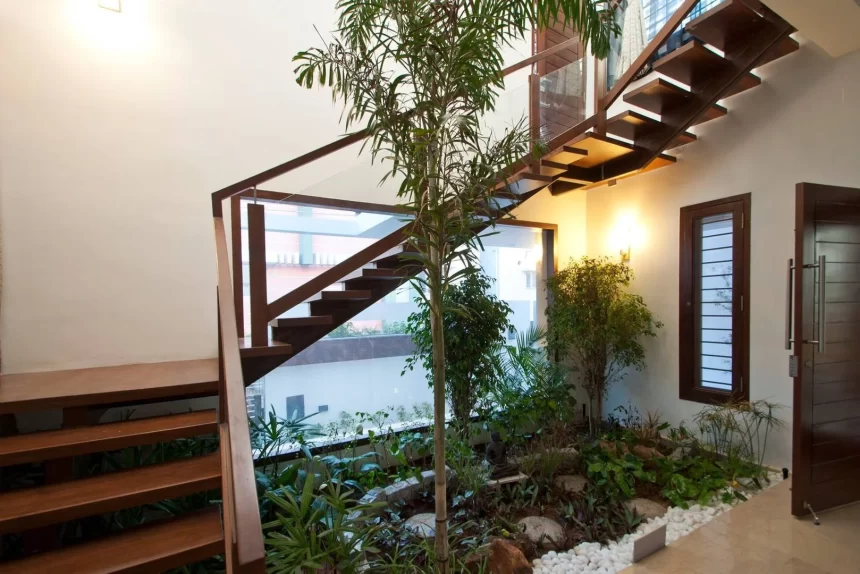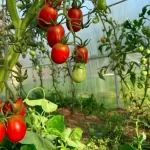The space under your stairs is often wasted, but it can be turned into a beautiful and useful indoor garden! With a little planning and effort, you can transform this empty area into a lovely green oasis.
Before starting, take a closer look at the space under your stairs. Consider the following:
Lighting
- Will natural light from nearby windows sufficiently brighten the area? If not, electrical lighting may need installing.
- Identify shadows that form throughout the day to pick optimal garden locations.
Dimensions
- Measure the area’s shape and total square footage for planning purposes.
- Identify any awkward angular architectural elements.
Accessibility
- Determine how to easily access the space for gardening and enjoyment. A small doorway may need widening.
Ventilation
- Under stairs areas often lack sufficient airflow. Consider incorporating vent holes to prevent mold/mildew.
Once thoroughly assessed, the exciting garden design process can begin!
Picking Plants for an Under Stairs Garden
When selecting plants, low-light houseplants able to thrive without direct sunlight are ideal. Consider the following green thumb recommendations:
Air Purifiers
Certain houseplants naturally filter airborne toxins and purify indoor spaces. Top air-purifying plants for under stairs gardens include:
- Spider Plant – Removes xylene, formaldehyde, carbon monoxide.
- English Ivy – Eliminates mold and fecal matter particles.
- Chrysanthemums – Absorbs benzene, ammonia and formaldehyde.
- Peace Lily – Removes acetone, alcohol and trichloroethylene.
Low-Light Warriors
While most plants depend on ample sunshine, these low-light warriors barely need any:
- Chinese Evergreen
- Cast Iron Plant
- Philodendrons
- Pothos
- Snake Plants
- ZZ Plants
Pet-Friendly Picks
If the home includes curious pets, choose pet-safe options:
- Boston Ferns
- Prayer Plants
- Parlor Palms
- Spider Plants
- Ponytail Palms
Creative Design Elements
Beyond plants, incorporate additional living and non-living elements to maximize visual appeal:
- Garden Lighting – String lights, lanterns or LED plant grow lights.
- Water Features – Mini waterfalls, petite ponds or tabletop fountains.
- Stepping Stones – Mosaic glass, slate, river rock pathways.
- Sculptures & Stepping Stones – Ceramic, metal or glass art pieces.
- Cozy Seating – Bench seating, cushions, pillows and throws.
By incorporating diverse plants, structures and accessories, an under stair space can utterly transform into a flourishing garden getaway!
Constructing the Garden Foundation
Before placing any garden elements, first, waterproof and beautify the stairs’ architectural framework. Consider taking these preparatory steps:
Moisture Protection
Frequently exposed to soil moisture, an under stairs garden risks leaking underneath into the basement if unprotected. Prevent leaks by:
- Waterproofing paint/sealants on exposed foundation walls
- Plastic moisture barrier sheeting affixed to stairs
- Rigid foam board insulation on surrounding walls
Aesthetic Improvements
Though flowers will visually distract, also spruce up dreary foundations for added beauty. Consider:
- Painting structural beams, ceilings and walls an uplifting color
- Affixing wood/marble panels over concrete surfaces
- Hanging curtains, tapestries or macramé art on banisters
- Disguising utility meters/pipes with decorative covers
Lighting Installations
Without sufficient lighting, plants will struggle thriving. Illuminate shadows by:
- Affixing inexpensive LED grow strip lights
- Mounting directional spotlights in dark corners
- Stringing festive lights along handrails
With the framework waterproofed, beautified and brightened, an indoor stair garden will flourish!
Garden Flooring Considerations
The flooring forms the garden’s foundation. When selecting materials, consider drainage, load-bearing capacity and aesthetics. Top options include:
Natural Stone
Slate or bluestone pavers add organic beauty while draining excess moisture. Opt for textured surfaces to prevent slippery slips.
Poured Concrete
For a contemporary vibe, poured concrete offers smoothing finishings like stained, stamped or polished concrete.
Decking
Pressure-treated cedar or redwood boards afford a lightweight, slatted wood floor. Opt for mildew-resistant composite decking alternatives like Trex impervious to moisture damage.
Gravel/Pebbles
Inexpensive and pervious, gravel diverts water and lending a quintessential garden aesthetic. Select larger pebbles over fine gravel to prevent messy dust and tracking.
Interlocking Rubber
Tiles Rubber pavers provide cushy, slip-resistant footing that’s durable, sound-dampening and comfortable underfoot.
Planters & Beds for Growing
To house planted greenery, incorporate versatile garden vessels in assorted shapes, sizes and styles. Consider these plant holder ideas:
- Hanging baskets mounted to railings
- Window boxes affixed under stairs or on banister posts
- Wood/metal/ceramic decorative planters
- Concrete/stone urns and pots
- Steel wire egg baskets fitted with coconut fiber liners
- Vertical living walls with affixed greenery
- Woodframed landscape beds filled with soil
- Tiered stair-stepped planters following stringer lines
By mingling different planter styles, visual Interest and depth materializes. Both edible and ornamental plants can thrive in containers – the only limit is your imagination!
Self-Watering Systems
Traveling hinders most indoor gardens, as plants inevitably become neglected and perish when left unattended without water. Yet self-watering containers prevent die-offs by automatically quenching plants’ thirst in your absence! Consider incorporating:
Wicking Beds
Layered with absorbent mediums like felt or burlap, wicking planters draw moisture through capillary action from a bottom water reservoir up into the soil.
Sub-Irrigated Planters (SIP)
With a water tank connected to grow beds via a vertical stand pipe, sub-irrigated planters soak plant roots without overwatering.
Passive Hydroponic Kits
No power required – these hydroponic systems feed plants through capillary films and grow media like perlite, gravel or coconut coir instead of soil.
Self-filling Water Globes/Spikes
As surrounding soil dries, the water glass/spike automatically empties until water is restored, preventing underwatering.
Oxygenating Plants
Certain water plants like pothos aerate and oxygenate water, keeping reservoirs and fountains cleaner for longer.
By integrating self-watering gardens, plants sustain while away – no matter how long!
Lush, Living Wall Installations
For blank, bleak walls around staircases, affixing mounted greenery vertically optimizes every square inch while purifying indoor air. To install living walls:
Hydroponic Panel Kits
Preformed modular panels with integrated irrigation systems easily mount like tiles to quickly greenify.
DIY Felt Planters
Affix felt planter pouches or pockets to a wall, inserting plants inside with the root ball facing outwards. Add grow lights above more demanding plants.
Wire Cages + Coir Pockets
Secure galvanized wire cages flush against surfaces, tucked inside stuff coir/moss pockets with plants. Use drip irrigation systems or manual watering.
With vibrant living walls installed,Upgrade concrete eyesores into thriving vertical oases!
Hardscaping for Garden Structure
While plants act as the garden focal point, hardscaping aspects provide underlying structure and organization. Incorporate hardscaping like:
Pathways
- Flat cobblestone walking paths
- Gravel garden trails with timber or brick edging
- Flagstone stepping stone tracks
- Mosaic tile stair risers
Raised Beds
- Stacked rock planter beds
- Brick/cinder block enclosures
- Wood framed boxes, with or without trellised walls
Borders
- Aluminum/steel corrugated garden edging
- Scalloped cement landscape curbing
- Intricately patterned mosaic tiles
By integrating paths, borders and beds, gardens gain crisp definition and orderly flow.
Additional Tips and Inspiration
When designing and cultivating an innovative under stairs garden, keep these extra pointers in mind:
- Choosing a Theme: Consider an ornamental theme providing visual unity, like a jungle oasis, miniature fairy garden, desertscape or carnivores collection.
- Playing with Heights: Incorporate multi-level and hanging elements for depth – try affixing wire shelves fitted with potted plants.
- Considering Safety: Use indoor-safe, non-toxic plants and childproof any electrical outlets. Prevent pests with natural deterrents like diatomaceous earth.
FAQs
Some top benefits include utilizing wasted space, purifying air, soaking up noise echoes, enjoying greenery year-round and having herbs and veggies close at hand in the kitchen. It also serves as a relaxing sanctuary and decorative showpiece.
Most under stairs spaces lack sufficient direct sunshine, so focus on low and medium light plants. Supplement with grow lights as needed, especially in winter when sunlight drastically diminishes.
Typical houseplant care applies like watering, pruning, cleaning leaves and regular fertilizing. Also monitor for pests, rotate pots and wipe down stair treads. Establish consistent routines for healthy plant growth.
Manual watering works fine, but automatic drip irrigation systems or self-watering planters make life easier when traveling. This ensures plants never go thirsty if away for prolonged periods.
The best plants thrive with low-moderate indirect sunlight and high humidity, like pothos, ferns, peace lilies, ivy, mosses, herbs, dracaenas and philodendrons. Pick plants suiting your stairwell’s unique lighting and environment.
Consider a theme and infuse creativity! Hang tapestries, artwork or strings of lights. Add architectural elements like water features, sculptures and cozy seating nooks. Paint walls vibrant colors and affix textured panels or wallpaper over concrete.
Being Realistic
Start small by choosing plants that are easy to take care of and can grow well in your space. As you learn more about gardening, you can slowly add more plants.
Enjoying the Process Instead of trying to do everything at once, plant and decorate your garden little by little over time. Part of the fun comes from the creative process of making your garden.
To get ideas, look at pictures of under stair gardens online or visit gardens and plant stores that show creative displays. Find plants and decorations that you like and that will work well with your stairs and style.
By mixing things you love and adding your own personal touch, your under stair garden becomes a unique, living work of art that shows off your passion and creativity. Soon, your new special spot will make your home feel fresh and bring joy to everyone who sees it.
The under stair garden is a small chance to make a big, beautiful change by growing plants in a small, personal space. But the good things about it spread into your everyday life. Gardens give us a peaceful place to relax and support us, all from tiny seeds growing in once empty, simple spaces.




